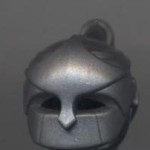Spotting non-LEGO parts isn’t always easy, but following a few simple guidelines can aid you on your quest to distinguish authentic LEGO pieces from other toy construction parts. Will the real LEGO pieces please stand up?
clone: a term used to describe LEGO knockoff brands like Mega Bloks, Kre-O or Best-Lock. Some LEGO clone pieces are compatible with LEGO bricks.
custom: an unofficial piece made out of LEGO or made to be compatible with LEGO. Custom pieces widely vary in quality and craftsmanship.
1. Look for the LEGO logo on the piece
Most LEGO pieces say LEGO somewhere on the piece. LEGO will commonly be written on a peg, if the piece has pegs. Be careful–occasional LEGO pieces DON’T SAY LEGO anywhere. You will learn these exceptions on a case by case basic over time. If you’re not sure if a piece is LEGO, just ask! One way to find out if a piece is genuine LEGO or not is by posting a photo on the BrickLink forum. Your friendly neighborhood BrickLink users will respond, identifying the piece for you.
2. Evaluate the the color and quality of the pieces
LEGO bricks have deeper, richer colors than Mega Bloks or other clones. Mega Bloks also feel lighter and are more cheaply made than LEGO.
3. Check the theme of the pieces
LEGO holds licensing agreements with popular franchises like Star Wars and Lord of the Rings. Mega Bloks, the largest LEGO competitor, holds agreements with HALO, Hello Kitty, Barbie, Hotwheels, World of WarCraft and others. If you spot a Hello Kitty, that’s not LEGO. Be careful, there are some exceptions! SpongeBob Squarepants licensed with LEGO from 2006 to 2012, but switched to Mega Bloks, releasing the first Mega Bloks sets in 2014.
4. Not all LEGO “looks” like LEGO
Over the years LEGO has produced some unconventional pieces that can get confused with other toy brands. There are LEGO dolls and LEGO toy cars that look like Hotwheels. Other official LEGO pieces like string or rubber bands could easily be mistaken for garbage, so keep a sharp eye.
5. NEVER assume an eBay or garage sale lot is 100% LEGO
Many lots advertised as “LEGO” on eBay, Craigslist or at garage sales will include at least a few non-LEGO pieces. Even if you ask the seller directly if the lot is 100% LEGO, some sellers naively assume that all plastic bricks are LEGO. Check the seller’s other items. If the seller has sold many other LEGO items then they are more likely to know the difference between LEGO an non-LEGO. On the other hand, if the the seller is using eBay basically as a garage sale and the “LEGO lot” is their only LEGO item, then that seller may have low LEGO expertise.
6. Watch out for bulk LEGO stock photos on eBay
Some sellers on eBay will post photos showing an example of what you’ll receive. “Example” photos of bulk LEGO lots are basically worthless since you’re blind to what you’re buying. How can you be sure the pieces you get will be authentic LEGO without seeing them? If you buy bulk lots with example photos, keep your expectations low and don’t expect to find any hidden gems like a 2002 Jango Fett minifig.
7. Ask for more detailed photos of LEGO lots
Your eyes are your best line of defense against LEGO impostors. Ideally you’d be able to examine pieces in person and up close, but seeing detailed, high resolution photos is your next best option.
8. Proceed with caution when buying “custom” items
Since custom items are not sanctioned by LEGO, quality of custom items widely varies. Read feedback comments and see if any buyers mention the quality of the custom item. Custom items should be listed as “custom” on eBay. If you buy an item advertised as genuine LEGO and receive a custom item, get a refund from the seller. Bait and switch tactics are both unethical and against the rules.


